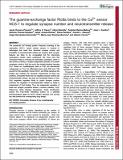Por favor, use este identificador para citar o enlazar a este item:
http://hdl.handle.net/10261/167910COMPARTIR / EXPORTAR:
 SHARE SHARE
 CORE
BASE CORE
BASE
|
|
| Visualizar otros formatos: MARC | Dublin Core | RDF | ORE | MODS | METS | DIDL | DATACITE | |

| Título: | The guanine-exchange factor Ric8a binds to the Ca2+ sensor NCS-1 to regulate synapse number and neurotransmitter release |
Autor: | Romero-Pozuelo, Jesús CSIC ORCID; Dason, J. S.; Mansilla, Alicia CSIC ORCID; Baños-Mateos, Soledad CSIC; Sardina, Jose Luis CSIC ORCID CVN; Chaves Sanjuán, Antonio CSIC ORCID; Jurado-Gómez, Jaime CSIC; Santana, Elena CSIC ORCID; Atwood, Harold Leslie; Hernández-Hernández, A.; Sánchez-Barrena, María José CSIC ORCID; Ferrús, Alberto CSIC ORCID | Fecha de publicación: | 2014 | Editor: | Company of Biologists | Citación: | Journal of Cell Science 127: 4246- 4259 (2014) | Resumen: | © 2014. Published by The Company of Biologists Ltd. The conserved Ca2+-binding protein Frequenin (homolog of the mammalian NCS-1, neural calcium sensor) is involved in pathologies that result from abnormal synapse number and probability of neurotransmitter release per synapse. Both synaptic features are likely to be co-regulated but the intervening mechanisms remain poorly understood. We show here that Drosophila Ric8a (a homolog of mammalian synembryn, which is also known as Ric8a), a receptor-independent activator of G protein complexes, binds to Frq2 but not to the virtually identical homolog Frq1. Based on crystallographic data on Frq2 and site-directed mutagenesis on Frq1, the differential amino acids R94 and T138 account for this specificity. Human NCS-1 and Ric8a reproduce the binding and maintain the structural requirements at these key positions. Drosophila Ric8a and Gas regulate synapse number and neurotransmitter release, and both are functionally linked to Frq2. Frq2 negatively regulates Ric8a to control synapse number. However, the regulation of neurotransmitter release by Ric8a is independent of Frq2 binding. Thus, the antagonistic regulation of these two synaptic properties shares a common pathway, Frq2- Ric8a-Gαs, which diverges downstream. These mechanisms expose the Frq2-Ric8a interacting surface as a potential pharmacological target for NCS-1-related diseases and provide key data towards the corresponding drug design. | URI: | http://hdl.handle.net/10261/167910 | DOI: | 10.1242/jcs.152603 | Identificadores: | doi: 10.1242/jcs.152603 issn: 1477-9137 |
| Aparece en las colecciones: | (IQF) Artículos |
Ficheros en este ítem:
| Fichero | Descripción | Tamaño | Formato | |
|---|---|---|---|---|
| 4246.full.pdf | 4,03 MB | Adobe PDF |  Visualizar/Abrir |
CORE Recommender
SCOPUSTM
Citations
27
checked on 16-abr-2024
WEB OF SCIENCETM
Citations
26
checked on 27-feb-2024
Page view(s)
241
checked on 22-abr-2024
Download(s)
255
checked on 22-abr-2024
Google ScholarTM
Check
Altmetric
Altmetric
NOTA: Los ítems de Digital.CSIC están protegidos por copyright, con todos los derechos reservados, a menos que se indique lo contrario.
